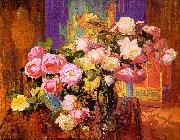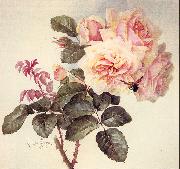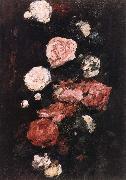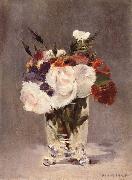
Oil On
Canvas, Real Flavor of Old Masters
|
Bischoff, Franz
|
|||
|
|
|||
| Austrian, practiced mainly in America, 1864-1929 was an American artist known primarily for his beautiful floral paintings and California landscapes. He was born in Bomen, Austria on January 9, 1864 and as a young teenager immigrated to the United States where he became a naturalized citizen. While in Europe, his early training was focused upon applied design, watercolor and ceramic decorations.After having lived and worked in New York, Fostoria, Ohio and Dearborn, Michigan, Franz Bischoff decided to visit California in 1900 and ultimately chose to settle in Los Angeles in 1906. Shortly after arriving, he started making arrangements to design and build a large Italian Renaissance style home in Pasadena that also became his studio. This landmark home was completed in 1908. Inspired by the California countryside, Bischoff set attempted to capture the area's brilliant light and diverse landscapes. Spending less time with ceramic painting, Bischoff painted local farms, fishing wharfs, and coastal landscapes. Recognized during his career for use of color and vivid composition, his paintings always displayed reverence for nature. | |||
|
|
|||
|
|
Roses new1/Bischoff, Franz1.jpg Painting ID:: 9792 Visit European Gallery |
oil on canvas. | |
Height Width |
INS/CM |
||
|
X |
|
||
|
|
|||
|
Longpre, Paul De
|
|||
|
|
|||
| French, practiced mainly in America, 1855-1911 was a French flower painter, actively chiefly in the United States. He was born in Lyons, France, and was entirely self-taught. From his twelfth year he practiced successfully in Paris as a painter of fans. At 21 he first exhibited at the Salon. Having lost his money by the failure of a Paris bank, he moved in 1890 to New York and in 1896 held an exhibition of flower pieces which secured him instant recognition. In 1899 he moved to California and two years later built a beautiful house at Hollywood, which became celebrated for its magnificent flower gardens. De Longpre painted only perfect specimens of flowers; with delicacy of touch and feeling for bosoms he united scientific knowledge, and he also knew how to give expression to the subtle essence of the flowers. | |||
|
|
|||
|
|
Roses new5/Longpre, Paul De_DeFnwt.jpg Painting ID:: 19203 Visit European Gallery |
watercolor, Irvine Museum, Irvine, CA. | |
Height Width |
INS/CM |
||
|
X |
|
||
|
|
|||
|
Nicolae Grigorescu
|
|||
|
|
|||
| Romanian Painter, 1838-1907 From 1848 he trained in Bucharest with various church painters, producing icons and religious mural decorations. These works, which soon attracted attention, were influenced in style by the Viennese classicism widespread in the Romanian principalities in the early 19th century and by the Italian academicism established there after 1850 by Gheorghe Tattarescu. The earliest of his known paintings are in the church of SS Constantin and Elena at Baicoi, where his signature can be seen beside that of Nita Pereescu on the icon of St George (1853). He subsequently painted a series of icons (1854-5) at Caldarusani Monastery. In the later ensembles he was assisted by his older brother Georghe Grigorescu, who participated under his direction in the decoration of churches, such as those of the Zamfira (1856-8) and Agapia (1858-60) monasteries. In Nicolae's paintings at Agapia, classicism in Romanian art reached its highest point. The royal icons are distinguished for the elegance of the figures, both in their attitudes and in their drapery. | |||
|
|
|||
|
|
Roses new4/Nicolae Grigorescu-735833.jpg Painting ID:: 30748 Visit European Gallery |
nn06 Oil on canvas | |
Height Width |
INS/CM |
||
|
X |
|
||
|
|
|||
|
Edouard Manet
|
|||
|
|
|||
| French Realist/Impressionist Painter, 1832-1883 The roughly painted style and photographic lighting in these works was seen as specifically modern, and as a challenge to the Renaissance works Manet copied or used as source material. His work is considered 'early modern', partially because of the black outlining of figures, which draws attention to the surface of the picture plane and the material quality of paint. He became friends with the Impressionists Edgar Degas, Claude Monet, Pierre-Auguste Renoir, Alfred Sisley, Paul Cezanne, and Camille Pissarro, through another painter, Berthe Morisot, who was a member of the group and drew him into their activities. The grand niece of the painter Jean-Honor?? Fragonard, Morisot's paintings first had been accepted in the Salon de Paris in 1864 and she continued to show in the salon for ten years. Manet became the friend and colleague of Berthe Morisot in 1868. She is credited with convincing Manet to attempt plein air painting, which she had been practicing since she had been introduced to it by another friend of hers, Camille Corot. They had a reciprocating relationship and Manet incorporated some of her techniques into his paintings. In 1874, she became his sister-in-law when she married his brother, Eugene. Self-portrait with palette, 1879Unlike the core Impressionist group, Manet maintained that modern artists should seek to exhibit at the Paris Salon rather than abandon it in favor of independent exhibitions. Nevertheless, when Manet was excluded from the International exhibition of 1867, he set up his own exhibition. His mother worried that he would waste all his inheritance on this project, which was enormously expensive. While the exhibition earned poor reviews from the major critics, it also provided his first contacts with several future Impressionist painters, including Degas. Although his own work influenced and anticipated the Impressionist style, he resisted involvement in Impressionist exhibitions, partly because he did not wish to be seen as the representative of a group identity, and partly because he preferred to exhibit at the Salon. Eva Gonzal??s was his only formal student. He was influenced by the Impressionists, especially Monet and Morisot. Their influence is seen in Manet's use of lighter colors, but he retained his distinctive use of black, uncharacteristic of Impressionist painting. He painted many outdoor (plein air) pieces, but always returned to what he considered the serious work of the studio. Manet enjoyed a close friendship with composer Emmanuel Chabrier, painting two portraits of him; the musician owned 14 of Manet's paintings and dedicated his Impromptu to Manet's wife. Throughout his life, although resisted by art critics, Manet could number as his champions Emile Zola, who supported him publicly in the press, Stephane Mallarme, and Charles Baudelaire, who challenged him to depict life as it was. Manet, in turn, drew or painted each of them. | |||
|
|
|||
|
|
Roses new10/Edouard Manet-467449.jpg Painting ID:: 34612 Visit European Gallery |
mk94 1882 | |
Height Width |
INS/CM |
||
|
X |
|
||
|
|
|||










